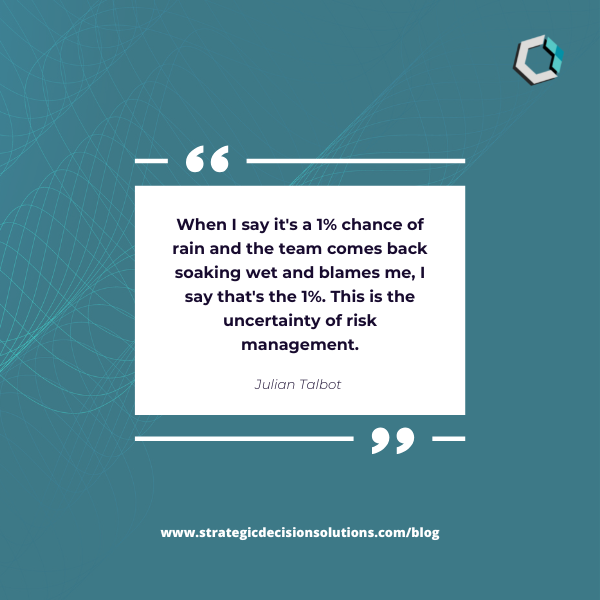To start today’s article, I would like to share a family story from July 2021…
My husband Nathan was taking our son Jackson to his first baseball game. The two of them took a “guys” trip to see a minor-league team in my former hometown about 3 hours away. On their way, they stopped at one of the many crystal-clear blue springs that dot our state’s landscape for a nice cool swim on this particularly hot afternoon.
The late July day was somewhat atypical for that time of the year, with clear skies most of the day and a low to almost zero chance of rain.
Not a zero chance mind you, but almost a zero chance. My Jackson found out what this means later that afternoon.
Shortly after their arrival at the Blue Wahoos Stadium in Pensacola, the decision was made to cancel the night’s game.
The reason?
A rain shower (on that “almost zero chance of rain” day) had soaked the inner dirt part of the field and made it unusable for that day’s game. The teams hoped it would dry up enough to play that evening, but there just wasn’t enough time.
The stadium was full, and everyone was ready for a good game. The whole experience was there; just no actual baseball!!
Fortunately, the team was gracious to issue a refund or apply the tickets to another game, so the guys returned a few weeks later for a full game of baseball.
I was reminded of this seemingly random, low probability event while listening to a webinar by risk thought leader, former CEO, and practitioner Julian Talbot. The broader subject of Julian’s talk focused what is known as black swans and how practitioners can use ISO 31000 to identify and assess them. I highly recommend watching it for background of a black swan and helpful tips on how to approach them.
The focus of today’s article isn’t necessarily on “black swans,” but I was naturally intrigued when Julian stated:

In the case of our baseball game story, the stadium was almost literally the only spot in the 11,000 square mile region known as the Florida Panhandle to see a rain shower that day. Team managers certainly watched the weather and apparently decided the risk of a storm was small enough to forego tarping the inner field.
In the case of low probability risks, the main question that needs to be asked is – what level of effort will it take to manage the risk?
I think you would agree that an afternoon rain shower in July in Florida hardly qualifies as a black swan. After all, this term is usually reserved to describe very low probability events that seemingly come out of nowhere and have huge ramifications. But as Julian explains in his webinar, examples of black swans listed on Wikipedia (e.g., Soviet Union collapse, 9/11 attacks, etc.) were not black swans to those who work around these issues day in and day out.
In my baseball example though, it wouldn’t have taken much effort to place a tarp over the inner field, especially considering the team does it all the time when the odds of rain are higher.
If you find yourself dealing with a similar situation, developing a range of options or responses to the risk to lower its impacts to the company is the first logical step to answering the question above. With these options in hand, you and company leaders should evaluate the risk/reward for each option, specifically:
- Time – this is more than just saying actions will take 5 hours, but rather, actions will take 5 (or 50!) hours from a specific person(s). Will this be acceptable considering that person’s other responsibilities?
- Spend – if it’s determined it will only cost $1,000 to reduce the risk by $5 million, then it sounds like a good investment. However, if it will require a massive financial outlay for little payoff, then efforts will be better spent elsewhere.
- Required skill sets and knowledge – Will taking action necessitate a specific knowledge base or set of skills? Does the company have someone with the required knowledge and/or skill set? If so, then go back to the time question above. If not, then go back to the spend question above.
- Opportunity costs – what are we giving up to focus on this risk? Is the lost opportunity worth the trade off?
- Amount of risk being reduced – For each of the options, determine what is the amount of risk reduction. This is helpful for comparing against the other information for that option.
This process is all about understanding how much risk the company is willing to take vs. how much the company is willing to spend. This concept at its core is – you guessed it – the fundamentals of risk appetite.
You may determine the risk to be unavoidable likely due to external factors outside of your control. In cases like this, the company will need to accept and closely monitor these risks. After all, choices have to be made in light of other priorities, resources, etc. because you can’t (and shouldn’t!) avoid or minimize everything. Anyone who tries to do so will quickly find themselves burnt out.
As we discuss often, ERM’s focus should not necessarily be about minimizing harm but achieving objectives and maximizing success.
With the amount of information and data available in today’s world, simply throwing your hands up and calling something a black swan is increasingly labelled as the lazy approach. Don’t be lazy.
Just because something has a low probability of happening doesn’t mean it won’t happen, which is why thought must be put into where to focus resources for maximum benefit.
Does your company ignore low probability events? Or does it take steps to understand which ones it can and should address?
To share your thoughts and experiences on this subject, please feel free to join the conversation on LinkedIn.
And if you prefer, you may share your thoughts privately by emailing comments@strategicdecisionsolutions.com.
If left unaddressed, it is possible for multiple low probability events to have a significant impact on a company’s long-term prospects. If your company is struggling to identify and assess risks like these, please don’t hesitate to contact me to schedule a one-on-one discussion!







